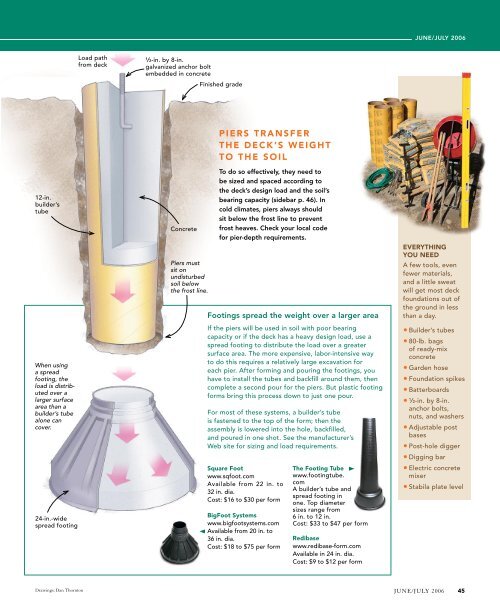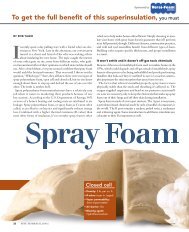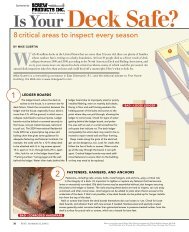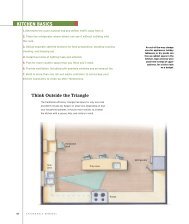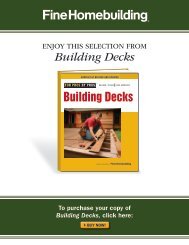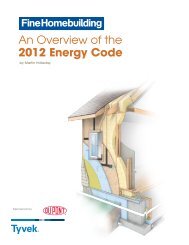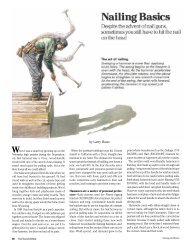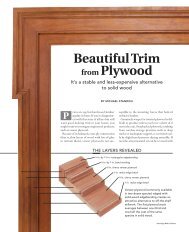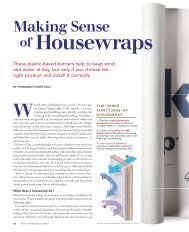A Solid Deck Begins with Concrete Piers - Fine Homebuilding
A Solid Deck Begins with Concrete Piers - Fine Homebuilding
A Solid Deck Begins with Concrete Piers - Fine Homebuilding
You also want an ePaper? Increase the reach of your titles
YUMPU automatically turns print PDFs into web optimized ePapers that Google loves.
12-in.<br />
builder’s<br />
tube<br />
When using<br />
a spread<br />
footing, the<br />
load is distributed<br />
over a<br />
larger surface<br />
area than a<br />
builder’s tube<br />
alone can<br />
cover.<br />
24-in.-wide<br />
spread footing<br />
Drawings: Dan Thornton<br />
Load path<br />
from deck<br />
1 ⁄2-in. by 8-in.<br />
galvanized anchor bolt<br />
embedded in concrete<br />
<strong>Concrete</strong><br />
<strong>Piers</strong> must<br />
sit on<br />
undisturbed<br />
soil below<br />
the frost line.<br />
Finished grade<br />
p i e R s t R a n s F e R<br />
t H e d e C K ’ s w e i G H t<br />
t o t H e s o i l<br />
To do so effectively, they need to<br />
be sized and spaced according to<br />
the deck’s design load and the soil’s<br />
bearing capacity (sidebar p. 46). In<br />
cold climates, piers always should<br />
sit below the frost line to prevent<br />
frost heaves. Check your local code<br />
for pier-depth requirements.<br />
Footings spread the weight over a larger area<br />
If the piers will be used in soil <strong>with</strong> poor bearing<br />
capacity or if the deck has a heavy design load, use a<br />
spread footing to distribute the load over a greater<br />
surface area. The more expensive, labor-intensive way<br />
to do this requires a relatively large excavation for<br />
each pier. After forming and pouring the footings, you<br />
have to install the tubes and backfill around them, then<br />
complete a second pour for the piers. But plastic footing<br />
forms bring this process down to just one pour.<br />
For most of these systems, a builder’s tube<br />
is fastened to the top of the form; then the<br />
assembly is lowered into the hole, backfilled,<br />
and poured in one shot. See the manufacturer’s<br />
Web site for sizing and load requirements.<br />
square Foot<br />
www.sqfoot.com<br />
Available from 22 in. to<br />
32 in. dia.<br />
Cost: $16 to $30 per form<br />
BigFoot systems<br />
www.bigfootsystems.com<br />
Available from 20 in. to<br />
36 in. dia.<br />
Cost: $18 to $75 per form<br />
the Footing tube<br />
www.footingtube.<br />
com<br />
A builder’s tube and<br />
spread footing in<br />
one. Top diameter<br />
sizes range from<br />
6 in. to 12 in.<br />
Cost: $33 to $47 per form<br />
Redibase<br />
www.redibase-form.com<br />
Available in 24 in. dia.<br />
Cost: $9 to $12 per form<br />
JUNE/JULY 2006<br />
eVeRytHinG<br />
yoU need<br />
A few tools, even<br />
fewer materials,<br />
and a little sweat<br />
will get most deck<br />
foundations out of<br />
the ground in less<br />
than a day.<br />
• Builder’s tubes<br />
• 80-lb. bags<br />
of ready-mix<br />
concrete<br />
• Garden hose<br />
• Foundation spikes<br />
• Batterboards<br />
• 1 ⁄2-in. by 8-in.<br />
anchor bolts,<br />
nuts, and washers<br />
• Adjustable post<br />
bases<br />
• post-hole digger<br />
• Digging bar<br />
• electric concrete<br />
mixer<br />
• Stabila plate level<br />
JUNE/JULy 2006 45


